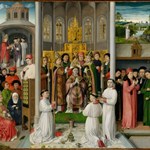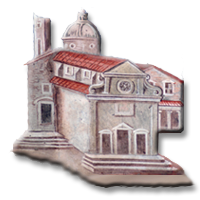This painting was the central panel of a triptych dedicated to Saint Augustine. The left wing is lost and right wing is now in the National Gallery of Ireland, Dublin. The composition is divided into five scenes: in the center Saint Augustine is consecrated bishop of Hippo; in the upper left Saint Augustine is ordained; in the lower left Saint Augustine preaches while his mother, Monica, says the rosary; in the upper right Saint Augustine converses with a boy who says that filling a hole in the sand with the sea is no more difficult than explaining the trinity, and in the lower right Saint Augustine preaches. Of particular interest in this panel are the detailed and richly depicted varieties of ecclesiastical vestments and altar implements, many examples of which are in the Treasury. These five panels are from a major altarpiece signed by Giovanni di Paolo and dated 1454. In the event that two of the saints—Augustine and Nicholas of Tolentino—are shown wearing the black, leather-belted habit of the Augustinian order (Augustine also wears a bishop's cope to signify his status as Bishop of Hippo, and next to him stands a figure probably intended to be his mother, Saint Monica), the altarpiece must have been painted for an Augustinian church. Giovanni di Paolo frequently worked for this order. Two suggested possibilities are the church of Sant'Agostino, Siena, or Sant'Agostino, Cortona. The latter possibility is based on the fact that the Metropolitan's altarpiece is documented as coming from the collection of Count Luigi Tommasi-Aleotti (modern spelling Aliotti) in Cortona. The Tommasi were prominent merchants in fifteenth-century Cortona, and they are known to have built a chapel in Sant'Agostino. One of them was named Niccolò, which could explain the inclusion of Saint Nicholas of Tolentino, who was canonized in 1446. However, we also know that in 1450 another merchant from Cortona, Zaccaria degli Bencivenni, endowed a chapel dedicated to Saint John the Baptist in the same church. Saint John the Baptist is prominent in the altarpiece and Bencivenni is another candidate for the patron (Gordon 2003). The altarpiece is not complete: it would have had pinnacles, a predella, and flanking piers, probably decorated with saints. The pinnacles have been identified with a series of the four evangelists and a figure of the blessing Christ (formerly Chiaramonte Bordonaro, Palermo, now in the Salini collection near Siena; see Christiansen 1982). An earlier proposal associating two panels with miracles of Saint Nicholas of Tolentino (Philadelphia Museum of Art and Akademie der bildenden Künste, Vienna) with the predella (Zeri and Gardner 1980) has now been discarded. Far more likely is the suggestion that the predella consisted of four scenes illustrating the life of Saint John the Baptist (National Gallery, London; for a full discussion and reconstruction of the altarpiece, see Gordon 2003, Fahy 2009, and Images). That the predella illustrated the life of Saint John the Baptist indicates that the altar was, indeed, dedicated to that saint, hence the interest of the Bencivenni-endowed chapel. The predella series is among the finest achievements of the artist, and the altarpiece as a whole was an important one. [2011]



